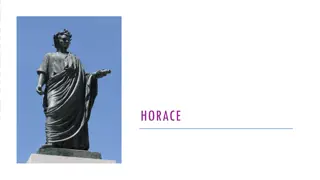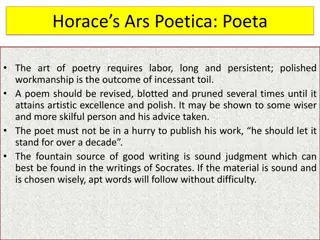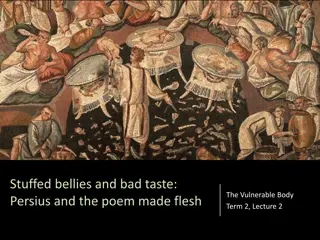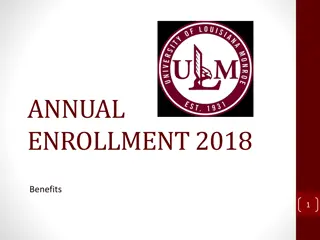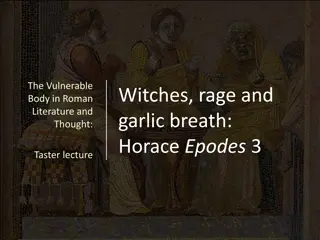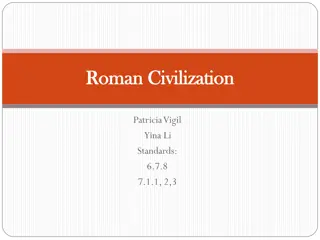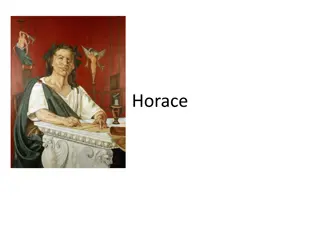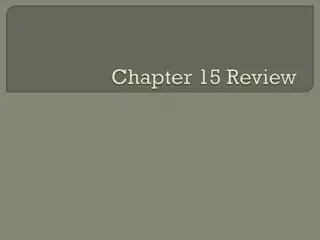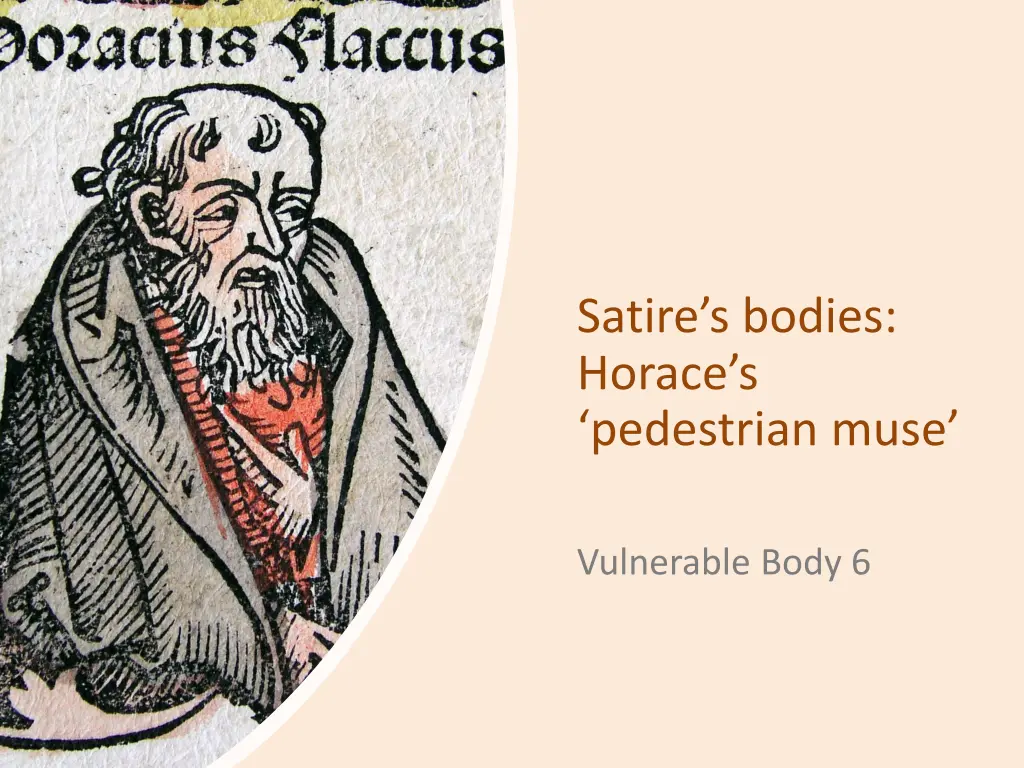
Exploring Horace's Satires: Social Inferiority and Self-Fashioning in Roman Poetry
Delve into the world of Horace's Satires, examining the themes of social inferiority, empowerment, and self-fashioning in ancient Roman poetry. Discover the nuances of satire as a tool for expression and survival in uncertain times, drawing parallels to modern artistic production and societal progress.
Download Presentation

Please find below an Image/Link to download the presentation.
The content on the website is provided AS IS for your information and personal use only. It may not be sold, licensed, or shared on other websites without obtaining consent from the author. If you encounter any issues during the download, it is possible that the publisher has removed the file from their server.
You are allowed to download the files provided on this website for personal or commercial use, subject to the condition that they are used lawfully. All files are the property of their respective owners.
The content on the website is provided AS IS for your information and personal use only. It may not be sold, licensed, or shared on other websites without obtaining consent from the author.
E N D
Presentation Transcript
Satires bodies: Horace s pedestrian muse Vulnerable Body 6
Key question [re.Horace]: to what extent can poses of social inferiority in the Roman world be expedient, even politically and creatively empowering? Might we perceive this phenomenon in the context of modern artistic production? What kind of positive associations are attached to the underdog ?
Roman verse Satire: food, fullness, miscellany satura satur satis lex per saturam * satura quidem tota nostra est satire, indeed, is all ours Quintilian 10.1.49
Satire in Latin, thus far ENNIUS (239-169BCE). Only 31 lines survive, metre varies. VARRO (i.e. M.Varro Reatinus 116-27BCE) VARRO OF ATAX (82-35BCE) LUCILIUS: floruit 130-103BC: hexameter verse satire. 1300 lines from 30 books survive. Horace s father-figure and foil. HORACE: Satires Book 1 published c.36- 35BCE; book 2 c.30BCE
The body of Horaces Satires Metre: hexameter, but not as we know it? Book 1: 10 poems (cf. Virgil s Eclogues, 42-39BCE) - Battle of Actium (31BC) - Book 2: 8 poems (but 2.3 very long, 326 lines) The Satires define themselves by negation: NOT fiery, over-extended, muddy , freedom-fighting Lucilius (Horace s Satires are literary , tight-lipped , even ? remarkably unsatirical ?) NOT the asymmetrical, spiky, 17-poem Epodes (or vice versa)
Self-fashioning and social progress through poetry? Poetry about poetry? (libello, little book is the last word of Satires book 1) The Satires are also a unique cultural document, a blueprint for how to survive in uncertain times and an individual view of one man s formation and emergence on the cusp between republic and empire (Gowers 2012, p1)
Sermo (conversation) Sat.1.4.40ff: First I will take my own name from the list of such as I would allow to be poets. For you would not call it enough to round off a verse, nor would you count anyone a poet who writes, as I do, lines more akin to prose (sermoni propriora).
Epist.2.1.250-57 As for me, I should not prefer my chats (sermones) that crawl along the ground (repentis per humum) to the story of great exploits (res gestas), the tale of distant lands and rivers, of forts on mountain tops, of barbaric realms, of the ending of wars under your auspices throughout the world, of bars that close on Janus, guardian of peace, and of that Rome who under your sway has become a terror to the Parthians if only I had power equal to my longing.
Grotesque bodies: moral as physical flaws The Satirist s own leaky/blemished body: Sat.1.5.7-8, 1.8.46, 1.6.66-7
Physiognomy and the Horatian grotesque Aristotle, Prior Analytics 2.27: It is possible to infer character from features, if it is granted that the body and the soul are changed together by the natural affections: I say "natural", for though perhaps by learning music a man has made some change in his soul, this is not one of those affections natural to us; rather I refer to passions and desires when I speak of natural emotions. If then this were granted and also that for each change there is a corresponding sign, and we could state the affection and sign proper to each kind of animal, we shall be able to infer character from features.
Satires 1.2: key point The poem illustrates one of the chief paradoxes of the genre: moralizing poetry is potentially besmirched by its filthy subject matter . (Gowers 2012)
Satire 1.1: strong and stable? Moderation and purity, or messy restlessness? A brand new voice for Roman verse satire, or a self-parodying agglomeration of clich s ? What kind of (paradoxical) blueprint for Roman satire?
Setting limits, and overstepping them Satires 1.1.120: iam satis est / Now that s enough Satires 1.2: begins in spirit of flamboyant excess. Code of simplicity , purity and decorum in adultery! Moderation = freedwomen (ease of access to their bodies)!
Sex and class In Sat.1.2, Horace is pinpointing the most vulnerable chinks in the armour of the ruling class the sexual transgressions of its womenfolk, and the humiliation of the men who turn a blind eye to those transgressions. (Gowers 2012, p89, paraphrased)
Takes one to know one? this is another triumphant demonstration of the outsider s invulnerability (Gowers on Sat.1.2: p89) But Satire itself requires the immoral body as the fons et origo of its own speech. (Gunderson 2005 The libidinal rhetoric of satire )
Writing the (satirists) body Sat.1.6.64: vita ac pectore puro (with a pure life and heart) Sat.1.5.7-8: Here, thanks to the water, which was disgusting, I declare war against my stomach, and wait impatiently while my companions dine. Sat.1.5.29-30: Here I put black ointment on eyes, being lippus (sore or watery-eyed, suffering from conjunctivitis). Meanwhile Maecenas arrives and Fonteius Capito, a man without flaw, so that Antony has no closer friend. Sat.1.6.65-7: if the flaws that mar my otherwise sound nature are minor and few in number, even as you might find fault with moles spotted over a good-looking person
Sat.1.8: the poet as (avenging victim ) Priapus vv.1-3: I was once a fig-wood stem, a worthless log, when the carpenter, undecided whether to make a stool or a Priapus, chose that I be a god vv.40-7: Why tell each detail .how I shuddered at the words and deeds of the two Furies, through not unavenged. For as loud as the noise of a bursting bladder was the crack when my fig- buttock split. Away they ran into town.
Satires 1.4: when is enough enough? Lines 105ff.: defining Horace s place in a satirical tradition - a new, biological, auto- biographical genealogy for satire? Genetic fathers replace literary ones? An aristocracy of virtue (Habinek) replaes social pedigree?
Nothing to see here: defensive manoeuvres in Sat.1.4 Sermones are not real poetry; no force, no passion, no bite; no one reads this! Take away the beat and rhythm, change the word order, and you ll see it s just chit-chat, not epic poetry that can do any harm. I am NOT Lucilius!!! I ll prove it with this example: take a slice of Ennius (father of Roman epic, a real poet, unlike me). Dismember the verse, and you ll still find the limbs of a poet! I am NOT Ennius! I am a lowly, harmless, unliterary satirist!
Ennius Ann.225-6 (Sk) Postquam Discordia taetra Belli ferratos postis portasque refregit. Imitated by Virgil at Aen.7.622 (Belli ferratos rumpit Saturnia postes) How epic can you get? War, grandiose diction, alliteration, metaphor Or how unpoetic can you get? So how epic, or how poetic , is Horatian satire? Is it really so harmless?

